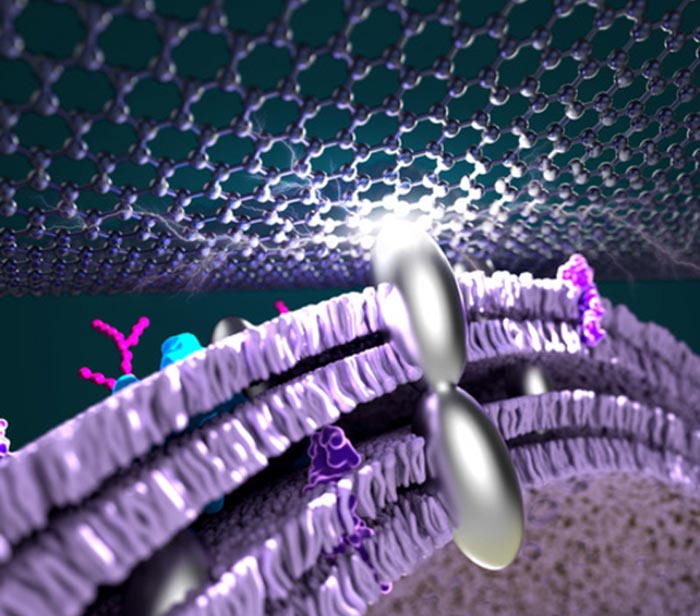Researchers infuse bacteria with silver to improve power efficiency in fuel cells

Artist's concept of a microbial fuel cell with efficiencies boosted by silver nanoparticles
Image created by AKang, Sphere Studio. Copyright: Yu Huang and Xiangfeng Duan
A UCLA-led team of engineers and chemists has taken a major step forward in the development of microbial fuel cells — a technology that utilizes natural bacteria to extract electrons from organic matter in wastewater to generate electrical currents. A study detailing the breakthrough was recently published in Science.
“Living energy-recovery systems utilizing bacteria found in wastewater offer a one-two punch for environmental sustainability efforts,” said co-corresponding author Yu Huang, a professor and chair of the Materials Science and Engineering Department at the UCLA Samueli School of Engineering. “The natural populations of bacteria can help decontaminate groundwater by breaking down harmful chemical compounds. Now, our research also shows a practical way to harness renewable energy from this process.”
The team focused on the bacteria genus Shewanella, which have been widely studied for their energy-generation capabilities. They can grow and thrive in all types of environments — including soil, wastewater and seawater — regardless of oxygen levels.
Shewanella species naturally break down organic waste matter into smaller molecules, with electrons being a byproduct of the metabolic process. When the bacteria grow as films on electrodes, some of the electrons can be captured, forming a microbial fuel cell that produces electricity.
However, microbial fuel cells powered by Shewanella oneidensis have previously not captured enough currents from the bacteria to make the technology practical for industrial use. Few electrons could move quickly enough to escape the bacteria’s membranes and enter the electrodes to provide sufficient electrical currents and power.
To address this issue, the researchers added nanoparticles of silver to electrodes that are composed of a type of graphene oxide. The nanoparticles release silver ions, which bacteria reduce to silver nanoparticles using electrons generated from their metabolic process and then incorporate into their cells. Once inside the bacteria, the silver particles act as microscopic transmission wires, capturing more electrons produced by the bacteria.
“Adding the silver nanoparticles into the bacteria is like creating a dedicated express lane for electrons, which enabled us to extract more electrons and at faster speeds,” said Xiangfeng Duan, the study’s other corresponding author and a professor of chemistry and biochemistry at UCLA.
With greatly improved electron transport efficiency, the resulting silver-infused Shewanella film outputs more than 80% of the metabolic electrons to external circuit, generating a power of 0.66 milliwatts per square centimeter — more than double the previous best for microbial-based fuel cells.
With the increased current and improved efficiencies, the study, which was supported by the Office of Naval Research, showed that fuel cells powered by silver-Shewanella hybrid bacteria may pave the way for sufficient power output in practical settings.
Bocheng Cao, a UCLA doctoral student advised by both Huang and Duan, is the first author of the paper. Other UCLA senior authors are Gerard Wong, a professor of bioengineering; Paul Weiss, a UC Presidential Chair and distinguished professor of chemistry and biochemistry, bioengineering, and materials science and engineering; and Chong Liu, an assistant professor of chemistry and biochemistry. Kenneth Nealson, a professor emeritus of earth sciences at USC, is also a senior author.
Duan, Huang and Weiss are all members of the California NanoSystems Institute at UCLA.
Journal: Science
DOI: 10.1126/science.abf3427
Method of Research: Experimental study
Subject of Research: Cells
Article Title: Silver nanoparticles boost charge extraction efficiency in Shewanella microbial fuel cells
Article Publication Date: 17-Sep-2021
COI Statement: An invention disclosure on MFC fabrication has been submitted to UCLA patent office
Media Contact
Christine Wei-li Lee
UCLA
clee@seas.ucla.edu
Office: (310) 206-0540
All latest news from the category: Life Sciences and Chemistry
Articles and reports from the Life Sciences and chemistry area deal with applied and basic research into modern biology, chemistry and human medicine.
Valuable information can be found on a range of life sciences fields including bacteriology, biochemistry, bionics, bioinformatics, biophysics, biotechnology, genetics, geobotany, human biology, marine biology, microbiology, molecular biology, cellular biology, zoology, bioinorganic chemistry, microchemistry and environmental chemistry.
Newest articles

Silicon Carbide Innovation Alliance to drive industrial-scale semiconductor work
Known for its ability to withstand extreme environments and high voltages, silicon carbide (SiC) is a semiconducting material made up of silicon and carbon atoms arranged into crystals that is…

New SPECT/CT technique shows impressive biomarker identification
…offers increased access for prostate cancer patients. A novel SPECT/CT acquisition method can accurately detect radiopharmaceutical biodistribution in a convenient manner for prostate cancer patients, opening the door for more…

How 3D printers can give robots a soft touch
Soft skin coverings and touch sensors have emerged as a promising feature for robots that are both safer and more intuitive for human interaction, but they are expensive and difficult…





















